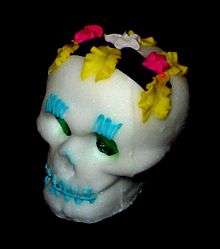Calavera

A calavera [plural:calaveras] (Spanish -pronounced: [kalaˈβeɾa] for "skull") is a representation of a human skull. The term is most often applied to decorative or edible skulls made (usually by hand) from either sugar (called Alfeñiques) or clay which are used in the Mexican celebration of the Day of the Dead (Día de los Muertos cona ) and the Roman Catholic holiday All Souls' Day. Calavera can also refer to any artistic representations of skulls, such as the lithographs of José Guadalupe Posada. The most widely known calaveras are created with cane sugar and are decorated with items such as colored foil, icing, beads, and feathers.[1]
Role
Traditional methods for producing calaveras have been in use since the 17th century CE.[2] The skulls are created either for children or as offerings to be placed on altars known as ofrendas for the Día de Muertos which has roots in the Aztec, Mayan, and Toltec cultural celebration of the Day of the Dead.[3]
In pre- Columbian times the images of skulls and skeletons were shown often in paintings, pottery, etc. representing rebirth into the next stage of life. During the 20th century a political caricaturist named Jose Guadalupe Posada became famous for making Calaveras as vain skeletons dressed in the clothing of the wealthy. The most famous one was Catrina, wearing a feathery hat and a long dress. Catrina is considered to be the personification of The Day of the Dead.[3] These skeletons are created from many materials such as wood, sugar paste varieties, types of nuts, chocolate, etc. When used as offerings, the name of the deceased is written across the forehead of the skull on colored foil.
Production

Traditional production methods have been in use since roughly the 15th century CE. The process involves using molds to cast the calaveras.[4] Production can be a lengthy process. A creator will usually spend roughly four to six months producing the skulls for a season. Traditionally-made sugar skulls are considered folk art and are not meant to be consumed.[4]
The production process is more focused on the aesthetic appeal of the skull than on the taste or food safety of the product. Furthermore, many calaveras feature inedible decorations, such as beads, feathers, and foil. Some skulls were formerly decorated with sombreros, though these designs have mostly disappeared since the 1970s.[4] The calaveras are then traditionally sold at outdoor market stalls beginning two weeks before the Day of the Dead.
Other calaveras are produced to be edible. Most are cast as one piece from cane sugar (which can either be left unflavored or flavored with vanilla[5]). Other calaveras may be made from chocolate. The calaveras are typically colored with vegetable dyes. Like the more decorative calaveras, these will sometimes have names written on the foreheads as well. Calaveras may be eaten, or kept for a few days and then thrown away.
Clay skulls
Clay toy variations of calaveras also resemble the shape of human skulls. These toys are often painted a metallic silver color, but they may also be found in colors such as white, black, and red. Beaded eyes of many colors may also be added to this toy.
Literary Calaveras
Poetry written for the Day of the Dead are known as literary calaveras, and are intended to humorously criticize the living while reminding them of their mortality.[6][7] Literary calaveras appeared during the second half of the nineteenth century, when drawings critical of important politicians began to be published in the press. Living personalities were depicted as skeletons exhibiting recognizable traits, making them easily identifiable. Additionally, drawings of dead personalities often contained text elements providing details of the deaths of various individuals.
See also
- Calacas skeleton.
- Papel Picado
- La Calavera Catrina Skeletons
- Santa Muerte, more skeletons
References
- ↑ About an José Guadalupe Mexicano Posada's Calavera Revolucionaria, retrieved 2007-11-13,
Posada created many images of calaveras (skeletons) performing many different human activities. These images were/are used for the Day of The Dead celebrations in Mexico.
- ↑ "Frequently Asked Questions about Day of the Dead, Sugar Skulls, Mexican Folk Art, Oilcloth & Papel Picado". www.mexicansugarskull.com. Retrieved 2015-07-01.
- 1 2 "Day of the Dead Sweets and Treats — Hungry History". Retrieved 2015-07-01.
- 1 2 3 "Frequently Asked Questions about Day of the Dead, Sugar Skulls, Mexican Folk Art, Oilcloth & Papel Picado". www.mexicansugarskull.com. Retrieved 2015-06-29.
- ↑ Stanley Brandes (8 January 2007). Skulls to the Living, Bread to the Dead: The Day of the Dead in Mexico and Beyond. Wiley-Blackwell. p. 43. ISBN 978-1-4051-5248-8.
- ↑ Rangel, Sonia. "Calavera poetry reading slated for Nov. 1". Tejano Tribune. Archived from the original on 2009-07-28. Retrieved 2007-11-13.
- ↑ Barradas, Francisco (2007-11-01). "Calaveras and Posadas". El Tecolote (in Spanish). Retrieved 2007-11-13.
External links
| Look up calavera in Wiktionary, the free dictionary. |